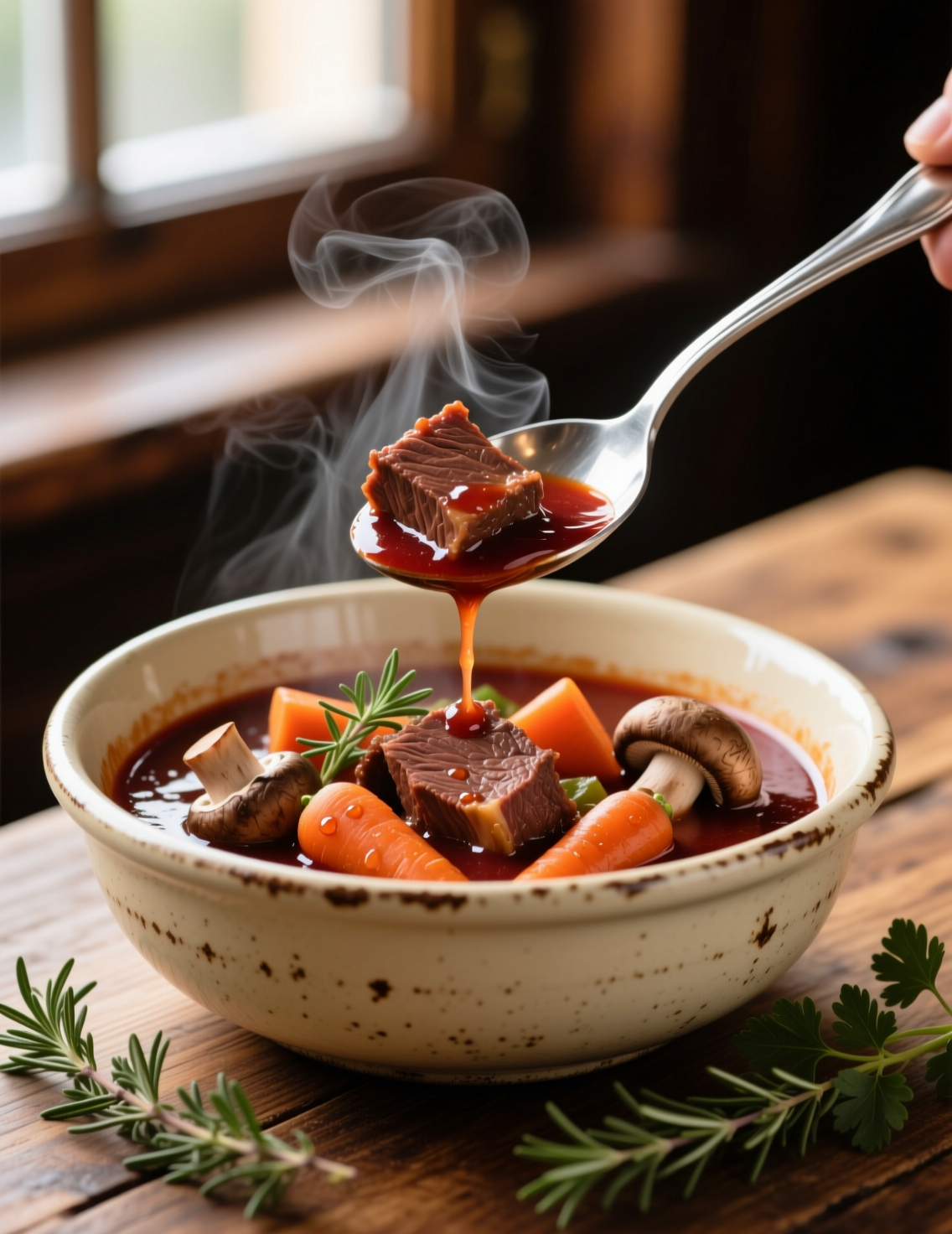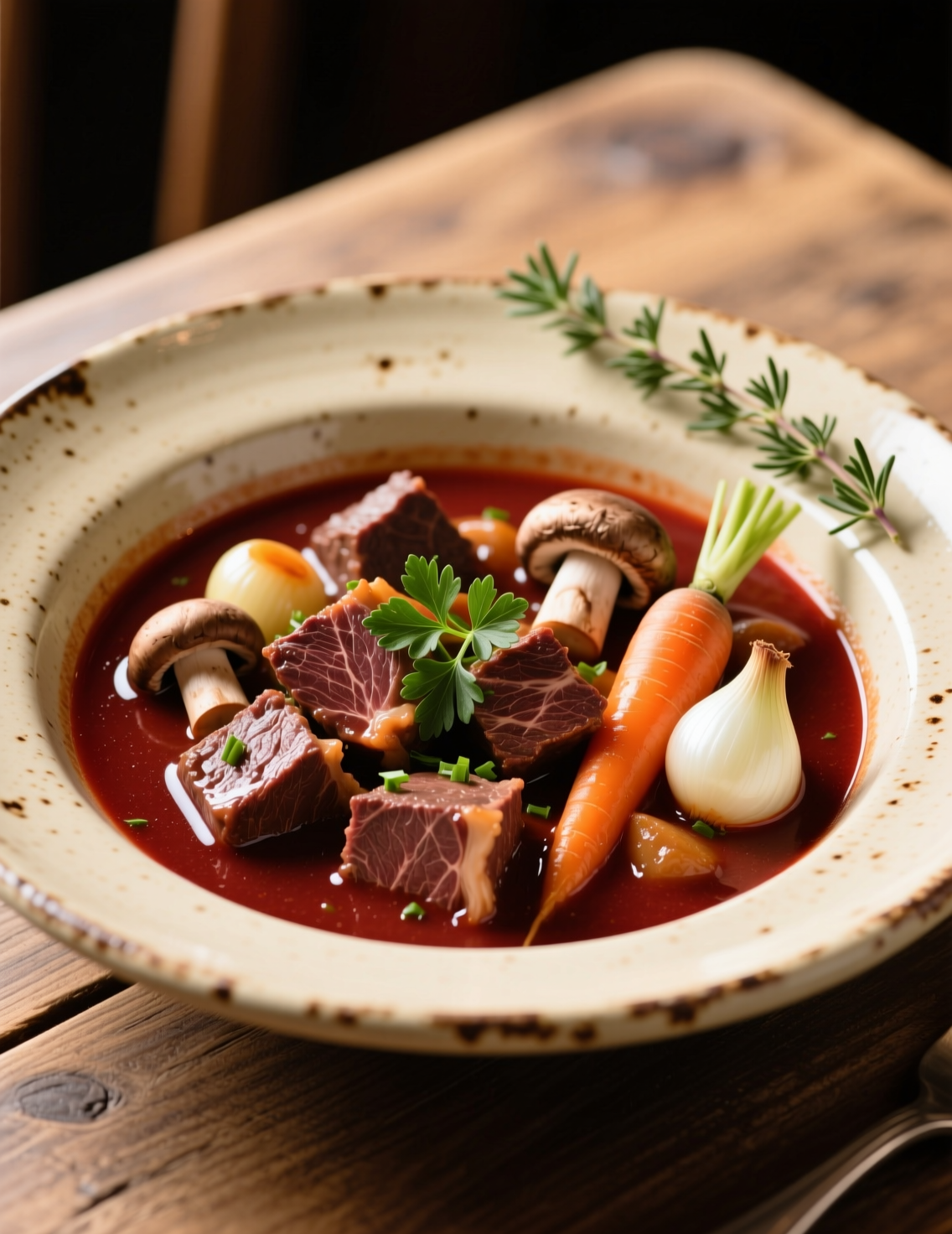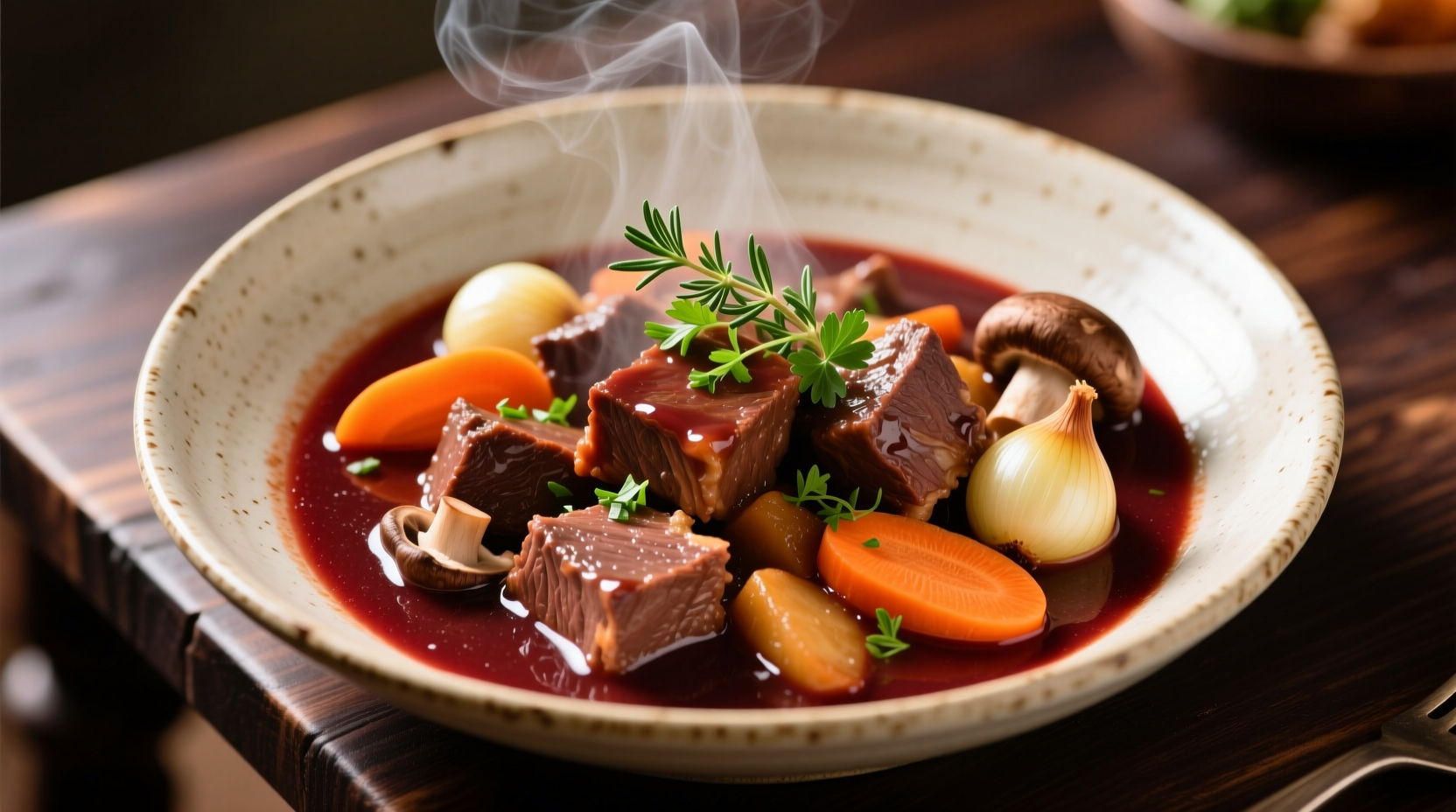French cuisine has a way of slowing you down. You can’t rush it, not if you want the flavors to sing properly. A French-style beef stew with red wine, known in its truest form as boeuf bourguignon, is more than just food—it’s technique wrapped in patience, layered with history, and executed with precision. Today, we’re not just cooking. We’re building something a bit timeless.
Why French-Style Beef Stew Matters
French stews aren’t just hearty dinners. They’re lessons in balance and depth. When Julia Child first brought boeuf bourguignon into American kitchens, it changed how people thought about stew. Suddenly, the humble pot of beef and vegetables became a symbol of sophistication.
But let’s step aside from nostalgia. The stew teaches professionals something vital: the ability of wine, aromatics, and time to transform tougher cuts into velvet-soft, flavorful masterpieces. It’s not about hiding flaws in the meat—it’s about elevating them.
Choosing the Right Cut of Beef
You can’t just throw any beef into the pot and call it French. Chuck roast is the gold standard. It has connective tissue that melts down beautifully after a few hours of braising. Some chefs swear by beef shin or brisket for their gelatin-rich qualities.
What matters most is marbling and structure. The slow braise will coax tenderness from collagen, but leaner cuts like sirloin will dry out. A 2022 survey of French culinary institutes revealed that over 70% of chefs teaching boeuf bourguignon recommend chuck as the most forgiving and flavorful option. That says a lot.
The Role of Red Wine
The wine isn’t just there for romance. It’s science at play. Red wine contains tannins and acids that break down muscle fibers while infusing layers of complexity. Burgundy wine is traditional, but any full-bodied red with good acidity will do—think Côtes du Rhône or even a Pinot Noir if you want a softer finish.
You’ll find debates among chefs about reducing the wine before braising. I’m in the camp that says: reduce it slightly. Not until it’s syrup, but enough to burn off harsh alcohol notes. A study in Food Chemistry Journal showed that simmering wine for just 15 minutes removes up to 70% of volatile alcohol compounds without losing aromatic complexity. That’s practical knowledge every pro should hold.

Vegetables: More Than Fillers
Carrots, onions, and celery—what the French call mirepoix—form the backbone of the stew. But it’s not as simple as throwing them in raw. The way you brown them determines the flavor base. Caramelization equals richness.
Mushrooms and pearl onions, added toward the end, bring freshness and textural contrast. Ever had a stew that felt one-note? That usually means all the vegetables melted away into the sauce without structural layers. Keep some crunch. Balance is king.
Building Layers of Flavor
Professional kitchens know this truth: the stew is only as strong as its weakest step. Browning beef properly is non-negotiable. Crowding the pan will steam the meat instead of searing it. That mistake happens more than anyone likes to admit.
Deglazing is where magic happens. Every dark bit stuck to the pan is pure gold. Red wine will pull it up, creating the foundation for the sauce. Skip this and you’ve robbed the dish of its complexity.
Step-by-Step Professional Recipe (6 Servings)
Ingredients
- 3 pounds beef chuck, cut into 2-inch cubes
- 2 cups dry red wine (Burgundy if possible)
- 3 cups beef stock, preferably homemade
- 3 tablespoons tomato paste
- 3 medium carrots, sliced thick
- 2 onions, chopped
- 2 celery ribs, chopped
- 4 garlic cloves, minced
- 1 bouquet garni (thyme, bay leaf, parsley stems tied in cheesecloth)
- 12 pearl onions, peeled
- 10 ounces mushrooms, quartered
- 3 tablespoons flour
- 4 tablespoons butter, divided
- 3 tablespoons olive oil
- Salt and freshly ground black pepper
Method
- Pat beef dry and season generously with salt and pepper.
- Heat oil and 2 tablespoons butter in a heavy Dutch oven. Brown beef in batches, ensuring a deep crust. Remove and set aside.
- In the same pot, sauté onions, carrots, and celery until lightly caramelized. Stir in garlic and cook for 1 minute.
- Add flour, stirring to coat vegetables. Cook 2 minutes to remove raw flour taste.
- Pour in red wine to deglaze, scraping fond from the pot. Reduce by a third.
- Stir in tomato paste and stock. Return beef to pot. Add bouquet garni.
- Bring to simmer, cover, and place in oven at 325°F (160°C). Cook 2.5 to 3 hours until beef is tender.
- Meanwhile, sauté mushrooms and pearl onions in remaining butter until golden. Add them to the stew for the last 30 minutes of cooking.
- Adjust seasoning. Discard bouquet garni before serving.
Serve with crusty French bread or buttered noodles. Nothing less will do justice.

Technique Tips Only Chefs Talk About
Don’t rush the browning. A deep sear locks in flavor, and professionals often let beef sit untouched for 4–5 minutes per side. Impatience is the enemy of flavor.
Don’t drown the meat in liquid. The beef should be just barely covered. Too much stock leads to a watery stew instead of a velvety sauce.
And here’s a small but big tip: rest the stew overnight. Like curries, braises improve the next day. The flavors knit together in a way you can’t replicate with speed. Michelin-trained chefs often reheat braises for service, not serve them fresh.
Common Mistakes Professionals Avoid
Adding wine straight from the bottle without reducing—it leaves a raw bite.
Skipping the bouquet garni—herbs scattered loose lose impact and cloud the sauce.
Overloading with vegetables—remember, this is beef’s show, everything else is supporting cast.
Not skimming fat from the top. Excess grease dulls the flavors and ruins mouthfeel.
Pairing and Presentation
This dish deserves wine alongside it. A Burgundy if you used one in cooking keeps the harmony. If not, a Syrah with peppery notes can cut through the richness.
Presentation matters, too. A rustic cocotte on the table feels right, but in fine dining, you might spoon portions into shallow white bowls, sauce glistening, with a sprinkle of fresh parsley. Professional plating is about intent.
The Broader Lessons from This Stew
Beyond the recipe, what does this dish teach a cook? Patience. Respect for raw ingredients. The value of layering. These aren’t just cooking tricks—they’re transferable skills. Any braise, any reduction, any sauce benefits from the same principles.
In fact, modern molecular gastronomy owes some debt to dishes like this. Chefs experimenting with sous-vide braises are essentially reinterpreting French classics, extending cooking times at precise temperatures to achieve tenderness without guesswork. Same philosophy, new tools.
Conclusion
French-style beef stew with red wine isn’t a dish you bang out for Tuesday lunch. It’s a practice in discipline and detail, something chefs use to ground themselves in technique. It teaches balance, respect, and timing.
For professionals, it’s a reminder that mastery often comes from the old before moving to the new. The next time you prepare boeuf bourguignon, don’t just cook it—study it. Notice how every choice, from the cut of beef to the timing of mushrooms, changes the whole. That’s not just dinner. That’s culinary education in a pot.
FAQs
What cut of beef is best for French-style beef stew?
Chuck roast is the top choice because it becomes tender and flavorful after slow braising.
Can I use any red wine for the stew?
Yes, but dry, full-bodied wines like Burgundy or Côtes du Rhône work best for depth and balance.
Do I need to marinate the beef before cooking?
No, searing and slow braising in wine and stock builds enough flavor without marinating.
Why should I reduce the wine before adding it?
Reducing burns off harsh alcohol notes and concentrates the wine’s flavor for a smoother sauce.
How long does French beef stew take to cook?
It usually takes around 2.5 to 3 hours in the oven for the beef to soften completely.
Can this stew be made ahead of time?
Yes, it tastes even better the next day as the flavors meld and deepen overnight.
What vegetables go into this stew traditionally?
Carrots, onions, celery, mushrooms, and pearl onions are the classic combination.
How do I avoid watery stew?
Keep liquid just enough to cover the beef; too much stock will thin the sauce.
What’s the best way to serve French-style beef stew?
Serve it with crusty bread, mashed potatoes, or buttered noodles to soak up the sauce.
Can I freeze leftover beef stew?
Yes, it freezes well for up to three months, though vegetables may soften slightly.

Mariana is a passionate home cook who creates delicious, easy-to-follow recipes for busy people. From energizing breakfasts to satisfying dinners and indulgent desserts, her dishes are designed to fuel both your body and hustle.
When she’s not in the kitchen, she’s exploring new flavors and dreaming up her next recipe to share with the Foodie Hustle community.

